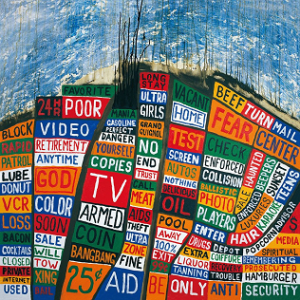When Hail to the Thief arrived in June 2003, it marked a pivotal moment in Radiohead’s evolution, standing as both a culmination and an expansion of the band’s artistic identity. Nestled between the experimental, electronic-driven landscapes of Kid A and Amnesiac and the more intimate, introspective In Rainbows that would follow, Hail to the Thief is often seen as a synthesis of the band’s polar creative instincts. It balances the lush textures of analog instrumentation with the fractured beats and digital alienation that had characterized their work at the turn of the millennium. This sixth studio album feels less like a retreat to rock and more like a kaleidoscopic summation of everything Radiohead had explored up to that point.
Released in a post-9/11 world gripped by political tension and cultural upheaval, Hail to the Thief channels a pervasive sense of unease. The album’s title itself—a veiled reference to the disputed 2000 U.S. presidential election—signals its engagement with themes of corruption, misinformation, and existential dread. Yet, as with much of Radiohead’s work, its intent is more oblique than overt, creating an atmosphere of paranoia and emotional displacement rather than delivering straightforward commentary.
From a conceptual standpoint, Hail to the Thief sees Radiohead grappling with the idea of control—or the lack thereof—on both personal and societal levels. Frontman Thom Yorke described the album as an attempt to confront “the creeping sense of fear” that had infiltrated modern life. Musically, the band sought to move away from the hyper-precision of their studio experiments, opting instead for a rawer, more spontaneous energy that captured their live sound. The result is an album both sprawling and immediate, a vivid tapestry where fractured beauty and simmering chaos coexist.
Sonic Exploration

The sonic fabric of Hail to the Thief is a restless, dynamic exploration of tension and release, mirroring the album’s thematic preoccupation with uncertainty and unease. Produced by longtime collaborator Nigel Godrich, the album strikes a delicate balance between polish and raw immediacy. Unlike the meticulous studio experimentation of Kid A and Amnesiac, much of Hail to the Thief was recorded quickly, with many tracks born from live takes. This approach imbues the album with a vibrant, unvarnished energy that feels both urgent and unrestrained. The production is crisp when it needs to be—bringing intricate layers of sound into sharp focus—but also gritty and unpredictable, amplifying the record’s volatile emotional core.
Musical Arrangements
Musically, the album’s arrangements are as varied as they are compelling. The instrumentation pivots between organic and synthetic textures, often within the same track. Jonny Greenwood’s intricate guitar work serves as a vital counterpoint to Thom Yorke’s plaintive, at times disembodied, vocals, while Colin Greenwood’s basslines weave a steady yet understated thread through the chaos.
Meanwhile, Phil Selway’s drumming oscillates between tight, driving rhythms and more fragmented, jazz-inflected patterns, anchoring the album’s wide-ranging soundscapes. Tracks like “2 + 2 = 5” and “There There” showcase Radiohead’s gift for building tension, layering sounds to create a sense of inexorable momentum before releasing it in cathartic bursts. Elsewhere, the ethereal “Sail to the Moon” and the haunting “Scatterbrain” lean into sparse, minimalist arrangements that foreground Yorke’s vulnerable vocal delivery.
Genre Elements
Hail to the Thief refuses to be pinned down to a single genre, instead weaving together elements of alternative rock, electronic, art rock, and even hints of folk and jazz. “Myxomatosis” pounds with distorted synths and a post-punk edge, while “Where I End and You Begin” dives into lush, hypnotic electronica. The band also dips into unconventional time signatures and harmonic progressions, further blurring the lines between traditional rock structures and experimental sound design. This genre-blending approach not only showcases the band’s musical versatility but also reinforces the album’s overarching themes of dislocation and complexity.
Lyrical Analysis

The lyrics of Hail to the Thief delve deep into themes of political disillusionment, existential anxiety, and the fragility of human connection. Thom Yorke’s writing, often cryptic and fragmented, conveys a pervasive sense of unrest, capturing the disjointed and chaotic nature of the early 21st century. Central to the album is a critique of power structures and manipulation, with recurring motifs of deceit, surveillance, and resistance running through tracks like “2 + 2 = 5” and “Sit Down. Stand Up.” Yorke refrains from outright polemics, favoring a more abstract, impressionistic approach that invites listeners to project their own fears and interpretations onto the words.
Recurring Themes
Recurring images of nature—storms, oceans, and the moon—serve as metaphors for tumultuous emotions and societal upheaval. In “Sail to the Moon,” Yorke invokes a lullaby-like cadence to explore themes of parental hope and existential longing, juxtaposing serenity with an underlying sense of dread. Similarly, “There There” uses mythic imagery of sirens to explore themes of temptation and alienation, warning, “Just ’cause you feel it doesn’t mean it’s there.” The recurring tension between perception and reality is a thread that ties the album’s lyrical fabric together.
Lyrically, Hail to the Thief leans heavily into abstraction and ambiguity, eschewing straightforward narratives for evocative fragments and cryptic phrases. Lines often feel like overheard snippets of a larger, hidden story, creating a sense of mystery that mirrors the album’s sonic complexity. This open-endedness allows the lyrics to resonate on multiple levels, whether as personal introspection, social commentary, or both. Yorke’s delivery—a mix of plaintive wails, fragile whispers, and soaring falsettos—imbues even the most abstract lines with palpable emotion, grounding the surreal in raw human feeling.
Emotional Impact
The emotional impact of the album’s lyrics is profound, eliciting a range of responses from unease to quiet contemplation. Songs like “A Wolf at the Door” are dense with biting, almost stream-of-consciousness wordplay, projecting a sense of suffocating paranoia. On the other hand, tracks like “Scatterbrain” evoke melancholy and introspection, their lyrics acting as a soft lament in the face of chaos. Throughout, Yorke’s words invite listeners to grapple with the dualities of fear and hope, despair and resilience, making Hail to the Thief not only a sonic but also a deeply emotional journey.
Cohesion and Flow

Hail to the Thief unfolds like a fever dream, its 14 tracks ebbing and flowing with a sense of deliberate yet unpredictable momentum. While the album doesn’t adhere to a strict narrative arc, there is a palpable emotional progression, moving from seething defiance to moments of tender vulnerability and back again. This dynamic range gives the album a sense of cohesion, even as it veers across diverse sonic and thematic landscapes.
The opening track, “2 + 2 = 5,” serves as a volatile introduction, starting with an almost deceptive calm before erupting into a frenetic climax that sets the tone for the rest of the album. From there, tracks flow into one another with an almost stream-of-consciousness logic. The sharp, jittery beats of “Backdrifts” bleed into the ominous, bass-heavy pulse of “Go to Sleep,” while the eerie, mechanical textures of “The Gloaming” provide a stark contrast to the organic, percussive build of “There There.” Each transition feels purposeful, maintaining a sense of unease while allowing moments of beauty to shine through.
Thematic Consistency
Despite its sprawling runtime, the album’s thematic consistency anchors it as a cohesive work. Paranoia, disillusionment, and the fragility of hope are recurring motifs, expressed not only through the lyrics but also in the restless interplay of musical styles. Even tracks that seem sonically disparate—such as the glitchy, minimalist “Myxomatosis” and the lush, melancholic “Scatterbrain”—feel connected by an overarching atmosphere of tension and introspection. This thematic unity prevents the album from feeling disjointed, even as it indulges in eclectic experimentation.
However, some listeners might find the sheer breadth of styles and ideas slightly overwhelming. The album’s length, coupled with its ambitious scope, can give the impression of excess, particularly in the latter half. Tracks like “We Suck Young Blood” and “I Will” slow the momentum, serving as brooding interludes that may feel jarring compared to the propulsive energy of earlier songs. Yet these moments of quiet intensity also serve to highlight the album’s emotional range, adding depth to its sonic and thematic palette.
Standout Tracks and Moments
Hail to the Thief is rich with standout tracks and moments that encapsulate Radiohead’s ability to meld innovation, emotion, and thematic depth. While the album as a whole thrives on its atmosphere of dissonance and ambiguity, certain songs rise to the forefront as pinnacles of its artistic vision.
Key Tracks
“2 + 2 = 5”
The album’s opener is a masterclass in tension and release, beginning with a sparse, eerie guitar line before exploding into a chaotic climax of distorted riffs and Thom Yorke’s frantic vocals. The track’s title, an allusion to George Orwell’s 1984, sets the tone for the album’s engagement with political paranoia and misinformation. The urgency and aggression of the song make it an unforgettable entry point into Hail to the Thief.
“There There”
A haunting and rhythmically intricate piece, “There There” stands as one of Radiohead’s most accessible yet profound tracks. Anchored by tribal percussion and shimmering guitars, the song builds to a euphoric crescendo, its layered production showcasing the band’s ability to create a soundscape that is both lush and haunting. Lyrically, it explores themes of longing and self-deception, with Yorke’s mantra-like refrain, “Just ’cause you feel it doesn’t mean it’s there,” resonating long after the track ends.
“Myxomatosis”
This snarling, synth-driven track captures the album’s darker, more abrasive edge. Its distorted bassline and Yorke’s sneering delivery create a sense of menace that perfectly aligns with its themes of manipulation and exploitation. The track’s raw, industrial energy makes it one of the most visceral moments on the album.
“A Wolf at the Door”
The closing track is a lyrical tour de force, blending surreal imagery with biting social commentary. Yorke’s rapid-fire delivery over a hypnotic, melancholic backdrop gives the song an almost dreamlike quality, its sinister undertones perfectly encapsulating the album’s mood. It’s a fitting conclusion, leaving the listener with a lingering sense of unease.
Memorable Moments
The Explosive Shift in “2 + 2 = 5”
The transition from the subdued opening to the frenetic chaos of the song’s climax is one of the album’s most thrilling moments. It captures Radiohead’s knack for defying expectations and using dynamic shifts to heighten emotional impact.
The Percussive Build in “There There”
The interplay of layered percussion and guitar builds to an ecstatic crescendo that feels almost ritualistic. It’s a moment where the band’s precision and emotional resonance converge seamlessly.
The Chilling Silence in “We Suck Young Blood”
This track’s slow, funeral-march tempo is punctuated by a sudden silence before an eerie clap breaks the tension. It’s a jarring, unforgettable moment that amplifies the song’s morbid atmosphere.
Yorke’s Vulnerable Falsetto in “Sail to the Moon”
The fragile beauty of Yorke’s vocals against the sparse, piano-driven arrangement creates a poignant moment of calm amid the album’s turbulence. The track’s celestial imagery and soothing cadence make it a standout moment of introspection.
Artistic Contribution and Innovation

Hail to the Thief occupies a fascinating space within Radiohead’s discography and the broader landscape of early-2000s music. Released at a time when the industry was reckoning with the explosion of digital media and shifting political climates, the album stood as both a reflection of its era and a continuation of Radiohead’s trajectory as trailblazers in the realm of experimental rock. While it may not have upended conventions as dramatically as OK Computer or Kid A, it nonetheless cemented the band’s reputation as artists unafraid to evolve, challenge norms, and defy expectations.
Place in Genre and Industry
In a music industry increasingly segmented by genre, Hail to the Thief reaffirmed Radiohead’s ability to transcend traditional boundaries. The album bridges the divide between alternative rock and electronic experimentation, weaving elements of art rock, post-punk, and glitch into a cohesive whole. Its sprawling nature and willingness to explore a variety of styles positioned it as a bold statement at a time when many bands were leaning toward more streamlined, commercial approaches. By resisting the urge to conform, Radiohead carved out a space where complexity and accessibility could coexist, influencing countless artists across genres to embrace risk-taking as a creative ethos.
Thematically, the album’s engagement with sociopolitical issues—though abstract and impressionistic—marked a significant moment in the intersection of music and cultural critique. While political albums were hardly new, Hail to the Thief approached its subject matter in a way that felt timely yet timeless, avoiding direct references in favor of capturing the pervasive atmosphere of fear and uncertainty. This approach resonated deeply in a post-9/11 world, offering a soundtrack to the unease that many listeners were grappling with.
Innovation
While Radiohead had already cemented themselves as innovators with the sonic revolutions of Kid A and Amnesiac, Hail to the Thief demonstrated a different kind of ingenuity: the ability to integrate their experimental impulses into a format that felt more immediate and organic. The album’s blend of live recording spontaneity and meticulous studio layering was groundbreaking in its own right, creating a sound that was raw yet intricately detailed. Tracks like “The Gloaming” and “Myxomatosis” showcase the band’s mastery of electronic textures, while songs like “There There” and “Go to Sleep” reaffirm their prowess in crafting dynamic, guitar-driven compositions.
Thematically, the album pushed boundaries by resisting narrative simplicity, instead using fragmented lyrics and unsettling arrangements to evoke feelings rather than tell stories. This approach was emblematic of Radiohead’s innovation—encouraging listeners to engage with the music on an interpretive level rather than consuming it passively. The integration of dystopian themes into the lyrical and sonic landscape also foreshadowed the increasing prominence of such ideas in the music of the 2010s and beyond.
Perhaps most innovative was Radiohead’s ability to explore the chaos of the modern world without succumbing to nihilism. The album’s sprawling, chaotic structure mirrors its thematic exploration of disorder, yet it retains moments of quiet beauty and emotional resonance. This balance of chaos and catharsis, dissonance and harmony, marked Hail to the Thief as a work that expanded the boundaries of what rock music could express.
Closing Thoughts

Hail to the Thief is an ambitious and sprawling album that captures Radiohead at a creative crossroads. Balancing the experimental tendencies of Kid A and Amnesiac with a return to the more organic instrumentation of their earlier work, the album represents a bold synthesis of the band’s evolving artistic identity. Its themes of political disillusionment, existential dread, and the fragile search for hope resonate deeply, while its eclectic sonic palette showcases Radiohead’s unparalleled ability to push boundaries without losing their emotional core.
One of the album’s greatest strengths is its willingness to take risks. Tracks like “2 + 2 = 5” and “There There” demonstrate the band’s mastery of dynamic tension and layered production, while more experimental pieces like “The Gloaming” and “Myxomatosis” delve into unsettling, boundary-pushing territory. At the same time, the album’s length and diversity can sometimes feel unwieldy, with a few tracks—such as “We Suck Young Blood” and “I Will”—interrupting the flow. These moments, while compelling in isolation, can make the album feel slightly less cohesive than some of Radiohead’s other works.
As a listener, Hail to the Thief invites reflection and exploration. Its emotional range—from paranoia and anger to quiet introspection—ensures that there is something here for everyone, though it may take multiple listens to fully grasp the depth of its complexity. In the context of Radiohead’s career, it stands as a transitional work, bridging the gap between the experimental daring of their early-2000s albums and the more intimate immediacy of In Rainbows.
Official Rating
Hail to the Thief earns a solid 8 out of 10 for its artistic ambition, thematic resonance, and memorable moments. While it doesn’t possess the singular focus of OK Computer or the revolutionary innovation of Kid A, it is a deeply rewarding album that highlights Radiohead’s continued evolution and their ability to remain relevant in an ever-changing musical landscape. Its occasional lapses in cohesion are outweighed by its brilliance, making it a must-listen for both devoted fans and newcomers seeking to understand what makes Radiohead one of the most influential bands of their era.
